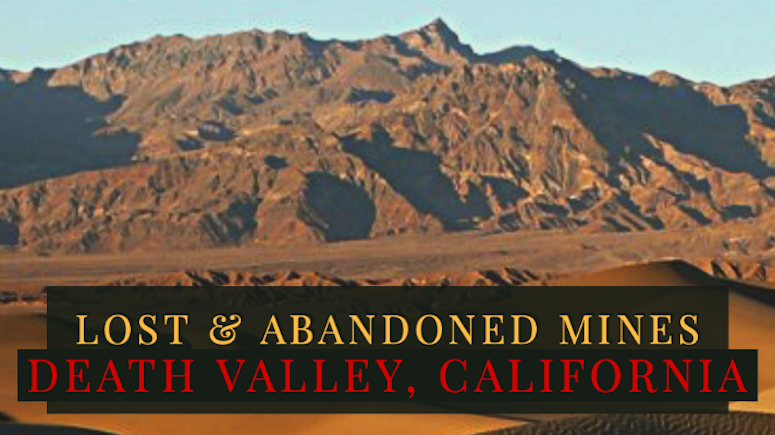
California has steadily evolved and kept up with changing times, which has helped the state to become one of the richest in the United States. The gold rush of 1849 started the mass movement of people to California.
Many mining towns in California that are now abandoned were once flooded with thousands of gold seekers. Many folks have all but forgotten that gold is what started it all.
And that gold wasn’t just in the famous “Mother Lode” of Northern California. Miners discovered the yellow metal from the border of Mexico to the border with Oregon and just about everywhere in between.
Death Valley – once a very intriguing place to mine gold in California – is now just a shadow of its former glory. It is now a national park and does not allow any active mining, but there was a time when this harsh, unforgiving desert was teeming with miners and fortune seekers.
A Period of Mixed Fortunes
The mines in Death Valley had a fairly good run for several decades from the time gold was discovered in the region. The yield started to dwindle from the 1880s; this lasted for about three decades.
During this period no large production of gold took place. The production was less than what was expected. Not one or two, many mining districts in the region suffered due to sporadic and limited gold production. Logistically, mining was very difficult. The extreme temperatures that occur brought unique challenges to the early miners.
Gold of various grades was still available in the region. But, a wide range of factors, including fuel shortage, water scarcity, logistical problems, inefficient technology, added to the woes of the miners. Only high-quality ore could be mined, but not much of that was available in Death Valley.
Scattered dry placers were found throughout the desert. With no water available the miners were limited to very slow, arduous methods of recovery. Even in rich locations it was difficult for a man to make a decent living without an efficient way to recover the gold.
The arrival of the drywasher improved recovery significantly. But it was hot, dusty dirty work and even under the best of circumstances it was tough for a miner to eek out a living digging gold in Death Valley.
Read: Southern California Gold Prospecting Locations
Large Scale Mining in the Death Valley
In the latter half of the 19th century, Death Valley witnessed several small and large scale mining operations. One of the more interesting operations was that of Harmony Borax Works. The mine was in business for just five years, from 1883 to 1888. It wasn’t gold that made the company famous. The company was best known for the Twenty Mule Team wagons.
These special wagons carried borax. The company also used the image of the wagon to promote its other products and interests.
After the general decline in production between 1880 and 1900, there was a sudden spike in interest in mining precious metals – gold and silver. New mines were started; the Rhyolite, Skidoo, and Keane Wonder were the largest ones operating in the Death Valley. With renewed interest in mining, large investments, and more jobs available, new towns began to grow and flourish.
The optimism and prosperity were short-lived. The financial crisis of 1907 also affected mining operations in the United States. During this period, prospectors also shifted their focus towards other minerals such as tungsten, zinc, lead, copper, and antimony. Profitable gold mining ended around 1915 in Death Valley.

Death Valley as a National Landmark
Even though large scale mining ceased to exist in Death Valley, prospectors and artisanal miners were still drawn to the region. Like many other towns, Death Valley was associated with the gold rush of the 19th century. Its history, along with the ecological significance of this region prompted the government to announce the Death Valley National Monument. The proclamation was signed by President Herbert Hoover in February 1933.
As a result of the proclamation, the prospecting of gold was banned in many areas of Death Valley. Filing for fresh claims on those lands was also banned. As expected, the move was met with strong opposition from prospectors. Later the same year, negotiations led to a Congressional action that lifted the ban on prospecting and mining in Death Valley.
Winding Down of Mining Activity in Death Valley
With the advancement of technology and the availability of heavy machinery, mining corporations looked at Death Valley with renewed interest. Strip and open-pit mining for talc and borax became the norm. International mining corporations started investing and buying claims in Death Valley. Uncontrolled mining in areas designated as a national monument caused a public outcry.
Finally, the Mining in the Parks Act was passed by Congress in 1976. The authorities stopped open-pit mines and banned filing of new mining claims. Existing mining activities were put on review.
In the early 1980s, limited mining activity was allowed after stricter environmental standards were set. In 1994, a new Death Valley National Park with 1.3 million acres was established. The park also controlled the numerous unpatented mining claims in the region.
Gradually gold mining activity decreased in the region. All mining operations except the Billie Mine came to a close. The underground borax mine was the only one to remain operational for nearly a decade in Death Valley. That too changed when the Billie Mine stopped its operations in 2005.
Next: Gold in the Mojave Desert of Arizona & Southern California
